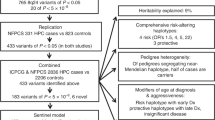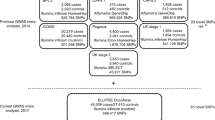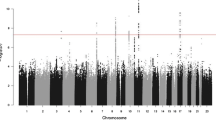Abstract
Genetic studies suggest that hereditary prostate cancer is a genetically heterogeneous disease with multiple contributing loci. Studies of high-risk prostate cancer families selected for aggressive disease, analysis of large multigenerational families, and a meta-analysis from the International Consortium for Prostate Cancer Genetics (ICPCG), all highlight chromosome 22q12.3 as a susceptibility locus with strong statistical significance. Recently, two publications have narrowed the 22q12.3 locus to a 2.18 Mb interval using 54 high-risk families from the ICPCG collaboration, as defined by three recombination events on either side of the locus. In this paper, we present the results from fine mapping studies at 22q12.3 using both haplotype and recombination data from 42 high-risk families contributed from the Mayo Clinic and the Prostate Cancer Genetic Research Study (PROGRESS) mapping studies. No clear consensus interval is present when all families are used. However, in the subset of 14 families with ≥5 affected men per family, a 2.53-Mb shared consensus segment that overlaps with the previously published interval is identified. Combining these results with data from the earlier ICPCG study reduces the three-recombination interval at 22q12.3 to approximately 1.36 Mb.



Similar content being viewed by others
References
Abecasis GR, Cherny SS, Cookson WO, Cardon LR (2002) Merlin–rapid analysis of dense genetic maps using sparse gene flow trees. Nat Genet 30:97–101
Berry R, Schroeder JJ, French AJ, McDonnell SK, Peterson BJ, Cunningham JM, Thibodeau SN, Schaid DJ (2000) Evidence for a prostate cancer-susceptibility locus on chromosome 20. Am J Hum Genet 67:82–91
Bratt O (2002) Hereditary prostate cancer: clinical aspects. J Urol 168:906–913
Camp NJ, Farnham JM, Cannon Albright LA (2005) Genomic search for prostate cancer predisposition loci in Utah pedigrees. Prostate 65:365–374
Camp NJ, Farnham JM, Cannon-Albright LA (2006) Localization of a prostate cancer predisposition gene to an 880-kb region on chromosome 22q12.3 in Utah high-risk pedigrees. Cancer Res 66:10205–10212
Camp NJ, Cannon-Albright LA, Farnham JM, Baffoe-Bonnie AB, George A, Powell I, Bailey-Wilson JE, Carpten JD, Giles GG, Hopper JL, Severi G, English DR, Foulkes WD, Maehle L, Moller P, Eeles R, Easton D, Badzioch MD, Whittemore AS, Oakley-Girvan I, Hsieh CL, Dimitrov L, Xu J, Stanford JL, Johanneson B, Deutsch K, McIntosh L, Ostrander EA, Wiley KE, Isaacs SD, Walsh PC, Thibodeau SN, McDonnell SK, Hebbring S, Schaid DJ, Lange EM, Cooney KA, Tammela TL, Schleutker J, Paiss T, Maier C, Gronberg H, Wiklund F, Emanuelsson M, Isaacs WB (2007) Compelling evidence for a prostate cancer gene at 22q12.3 by the International Consortium for Prostate Cancer Genetics. Hum Mol Genet 16:1271–1278
Carlson CS, Eberle MA, Rieder MJ, Yi Q, Kruglyak L, Nickerson DA (2004) Selecting a maximally informative set of single-nucleotide polymorphisms for association analyses using linkage disequilibrium. Am J Hum Genet 74:106–120
Carter BS, Beaty TH, Steinberg GD, Childs B, Walsh PC (1992) Mendelian inheritance of familial prostate cancer. Proc Natl Acad Sci USA 89:3367–3371
Chang BL, Isaacs SD, Wiley KE, Gillanders EM, Zheng SL, Meyers DA, Walsh PC, Trent JM, Xu J, Isaacs WB (2005) Genome-wide screen for prostate cancer susceptibility genes in men with clinically significant disease. Prostate 64:356–361
Chang BL, Lange EM, Dimitrov L, Valis CJ, Gillanders EM, Lange LA, Wiley KE, Isaacs SD, Wiklund F, Baffoe-Bonnie A, Langefeld CD, Zheng SL, Matikainen MP, Ikonen T, Fredriksson H, Tammela T, Walsh PC, Bailey-Wilson JE, Schleutker J, Gronberg H, Cooney KA, Isaacs WB, Suh E, Trent JM, Xu J (2006) Two-locus genome-wide linkage scan for prostate cancer susceptibility genes with an interaction effect. Hum Genet 118:716–724
Chang KW, Lee TC, Yeh WI, Chung MY, Liu CJ, Chi LY, Lin SC (2004) Polymorphism in heme oxygenase-1 (HO-1) promoter is related to the risk of oral squamous cell carcinoma occurring on male areca chewers. Br J Ca 91:1551–1554
Conlon EM, Goode EL, Gibbs M, Stanford JL, Badzioch M, Janer M, Kolb S, Hood L, Ostrander EA, Jarvik GP, Wijsman EM (2003) Oligogenic segregation analysis of hereditary prostate cancer pedigrees: evidence for multiple loci affecting age at onset. Int J Cancer 105:630–635
Cook Jr EH (2002) Merlin: faster linkage analysis with improved genotyping error detection. Pharmacogenomics J 2:139–140
Cui J, Staples MP, Hopper JL, English DR, McCredie MR, Giles GG (2001) Segregation analyses of 1,476 population-based Australian families affected by prostate cancer. Am J Hum Genet 68:1207–1218
Cunningham JM, McDonnell SK, Marks A, Hebbring S, Anderson SA, Peterson BJ, Slager S, French A, Blute ML, Schaid DJ, Thibodeau SN (2003) Genome linkage screen for prostate cancer susceptibility loci: results from the Mayo Clinic Familial Prostate Cancer Study. Prostate 57:335–3346
Cybulski C, Wokolorczyk D, Huzarski T, Byrski T, Gronwald J, Gorski B, Debniak T, Masojc B, Jakubowska A, Gliniewicz B, Sikorski A, Stawicka M, Godlewski D, Kwias Z, Antczak A, Krajka K, Lauer W, Sosnowski M, Sikorska-Radek P, Bar K, Klijer R, Zdrojowy R, Malkiewicz B, Borkowski A, Borkowski T, Szwiec M, Narod SA, Lubinski J (2006) A large germline deletion in the Chek2 kinase gene is associated with an increased risk of prostate cancer. J Med Genet 43:863–866
Dong X, Wang L, Taniguchi K, Wang X, Cunningham JM, McDonnell SK, Qian C, Marks AF, Slager SL, Peterson BJ, Smith DI, Cheville JC, Blute ML, Jacobsen SJ, Schaid DJ, Tindall DJ, Thibodeau SN, Liu W (2003) Mutations in CHEK2 associated with prostate cancer risk. Am J Hum Genet 72:270–280
Dorkeld F, Bernheim A, Dessen P, Huret JL (1999) A database on cytogenetics in haematology and oncology. Nucleic Acids Res 27:353–354
Easton DF, Schaid DJ, Whittemore AS, Isaacs WJ (2003) Where are the prostate cancer genes?–A summary of eight genome wide searches. Prostate 57:261–269
Goldgar DE, Easton DF, Cannon-Albright LA, Skolnick MH (1994) Systematic population-based assessment of cancer risk in first-degree relatives of cancer probands. J Natl Cancer Inst 86:1600–1608
Gong G, Oakley-Girvan I, Wu AH, Kolonel LN, John EM, West DW, Felberg A, Gallagher RP, Whittemore AS (2002) Segregation analysis of prostate cancer in 1,719 white, African–American and Asian–American families in the United States and Canada. Cancer Causes Control 13:471–482
Gronberg H, Damber L, Damber JE, Iselius L (1997) Segregation analysis of prostate cancer in Sweden: support for dominant inheritance. Am J Epidemiol 146:552–557
IHC (2003) The international HapMap project. Nature 426:789–796
Janer M, Friedrichsen DM, Stanford JL, Badzioch MD, Kolb S, Deutsch K, Peters MA, Goode EL, Welti R, DeFrance HB, Iwasaki L, Li S, Hood L, Ostrander EA, Jarvik GP (2003) Genomic scan of 254 hereditary prostate cancer families. Prostate 57:309–319
Jemal A, Siegel R, Ward E, Murray T, Xu J, Thun MJ (2007) Cancer statistics, 2007. CA Cancer J Clin 57:43–66
Keetch DW, Rice JP, Suarez BK, Catalona WJ (1995) Familial aspects of prostate cancer: a case control study. J Urol 154:2100–2102
Kruglyak L, Daly MJ, Reeve-Daly MP, Lander ES (1996) Parametric and nonparametric linkage analysis: a unified multipoint approach. Am J Hum Genet 58:1347–1363
Lange EM, Gillanders EM, Davis CC, Brown WM, Campbell JK, Jones M, Gildea D, Riedesel E, Albertus J, Freas-Lutz D, Markey C, Giri V, Dimmer JB, Montie JE, Trent JM, Cooney KA (2003) Genome-wide scan for prostate cancer susceptibility genes using families from the University of Michigan prostate cancer genetics project finds evidence for linkage on chromosome 17 near BRCA1. Prostate 57:326–334
Markianos K, Daly MJ, Kruglyak L (2001) Efficient multipoint linkage analysis through reduction of inheritance space. Am J Hum Genet 68:963–977
McIndoe RA, Stanford JL, Gibbs M, Jarvik GP, Brandzel S, Neal CL, Li S, Gammack JT, Gay AA, Goode EL, Hood L, Ostrander EA (1997) Linkage analysis of 49 high-risk families does not support a common familial prostate cancer-susceptibility gene at 1q24–25. Am J Hum Genet 61:347–353
Nievergelt CM, Smith DW, Kohlenberg JB, Schork NJ (2004) Large-scale integration of human genetic and physical maps. Genome Res 14:1199–1205
Ostrander EA, Stanford JL (2000) Genetics of prostate cancer: too many loci, too few genes. Am J Hum Genet 67:1367–1375
Ostrander EA, Markianos K, Stanford JL (2004) Finding prostate cancer susceptibility genes. Annu Rev Genomics Hum Genet 5:151–175
Pakkanen S, Baffoe-Bonnie AB, Matikainen MP, Koivisto PA, Tammela TL, Deshmukh S, Ou L, Bailey-Wilson JE, Schleutker J (2007) Segregation analysis of 1,546 prostate cancer families in Finland shows recessive inheritance. Hum Genet 121:257–267
Rozen S, Skaletsky H (2000) Primer3 on the WWW for general users and for biologist programmers. Methods Mol Biol 132:365–386
Schaid DJ (2004) The complex genetic epidemiology of prostate cancer. Hum Mol Genet 13(Spec No 1):R103–R121
Schaid DJ, McDonnell SK, Blute ML, Thibodeau SN (1998) Evidence for autosomal dominant inheritance of prostate cancer. Am J Hum Genet 62:1425–1438
Schaid DJ, Guenther JC, Christensen GB, Hebbring S, Rosenow C, Hilker CA, McDonnell SK, Cunningham JM, Slager SL, Blute ML, Thibodeau SN (2004) Comparison of microsatellites versus single-nucleotide polymorphisms in a genome linkage screen for prostate cancer-susceptibility Loci. Am J Hum Genet 75:948–965
Seppala EH, Ikonen T, Mononen N, Autio V, Rokman A, Matikainen MP, Tammela TL, Schleutker J (2003) CHEK2 variants associate with hereditary prostate cancer. Br J Cancer 89:1966–1970
Smith JR, Freije D, Carpten JD, Gronberg H, Xu J, Isaacs SD, Brownstein MJ, Bova GS, Guo H, Bujnovszky P, Nusskern DR, Damber JE, Bergh A, Emanuelsson M, Kallioniemi OP, Walker-Daniels J, Bailey-Wilson JE, Beaty TH, Meyers DA, Walsh PC, Collins FS, Trent JM, Isaacs WB (1996) Major susceptibility locus for prostate cancer on chromosome 1 suggested by a genome-wide search. Science 274:1371–1374
Stanford JL, McDonnell SK, Friedrichsen DM, Carlson EE, Kolb S, Deutsch K, Janer M, Hood L, Ostrander EA, Schaid DJ (2006) Prostate cancer and genetic susceptibility: a genome scan incorporating disease aggressiveness. Prostate 66:317–325
Tapper WJ, Morton NE, Dunham I, Ke X, Collins A (2001) A sequence-based integrated map of chromosome 22. Genome Res 11:1290–1295
Valeri A, Briollais L, Azzouzi R, Fournier G, Mangin P, Berthon P, Cussenot O, Demenais F (2003) Segregation analysis of prostate cancer in France: evidence for autosomal dominant inheritance and residual brother-brother dependence. Ann Hum Genet 67:125–137
Verhage BA, Baffoe-Bonnie AB, Baglietto L, Smith DS, Bailey-Wilson JE, Beaty TH, Catalona WJ, Kiemeney LA (2001) Autosomal dominant inheritance of prostate cancer: a confirmatory study. Urology 57:97–101
Xu J, Dimitrov L, Chang BL, Adams TS, Turner AR, Meyers DA, Eeles RA, Easton DF, Foulkes WD, Simard J, Giles GG, Hopper JL, Mahle L, Moller P, Bishop T, Evans C, Edwards S, Meitz J, Bullock S, Hope Q, Hsieh CL, Halpern J, Balise RN, Oakley-Girvan I, Whittemore AS, Ewing CM, Gielzak M, Isaacs SD, Walsh PC, Wiley KE, Isaacs WB, Thibodeau SN, McDonnell SK, Cunningham JM, Zarfas KE, Hebbring S, Schaid DJ, Friedrichsen DM, Deutsch K, Kolb S, Badzioch M, Jarvik GP, Janer M, Hood L, Ostrander EA, Stanford JL, Lange EM, Beebe-Dimmer JL, Mohai CE, Cooney KA, Ikonen T, Baffoe-Bonnie A, Fredriksson H, Matikainen MP, Tammela T, Bailey-Wilson J, Schleutker J, Maier C, Herkommer K, Hoegel JJ, Vogel W, Paiss T, Wiklund F, Emanuelsson M, Stenman E, Jonsson BA, Gronberg H, Camp NJ, Farnham J, Cannon-Albright LA, Seminara D (2005) A combined genomewide linkage scan of 1,233 families for prostate cancer-susceptibility genes conducted by the international consortium for prostate cancer genetics. Am J Hum Genet 77:219–229
Zhang Y, Kiel DP, Ellison RC, Schatzkin A, Dorgan JF, Kreger BE, Cupples LA, Felson DT (2002) Bone mass and the risk of prostate cancer: the Framingham Study. Am J Med 113:734–739
Acknowledgments
This research was supported by grants from the National Institutes of Health R01 CA80122 (JLS), RO1 CA78836 (EAO), RO1 CA089600, and RO1 CA72818 (SNT and DS), with additional support from the Prostate Cancer Foundation, the Fred Hutchinson Cancer Research Center, the Intramural Program of the National Human Genome Research Institute and the Center for Inherited Disease Research. We are grateful for the continued participation of PROGRESS and Mayo family members in this research.
Author information
Authors and Affiliations
Corresponding author
Electronic supplementary material
Rights and permissions
About this article
Cite this article
Johanneson, B., McDonnell, S.K., Karyadi, D.M. et al. Fine mapping of familial prostate cancer families narrows the interval for a susceptibility locus on chromosome 22q12.3 to 1.36 Mb. Hum Genet 123, 65–75 (2008). https://doi.org/10.1007/s00439-007-0451-y
Received:
Accepted:
Published:
Issue Date:
DOI: https://doi.org/10.1007/s00439-007-0451-y




